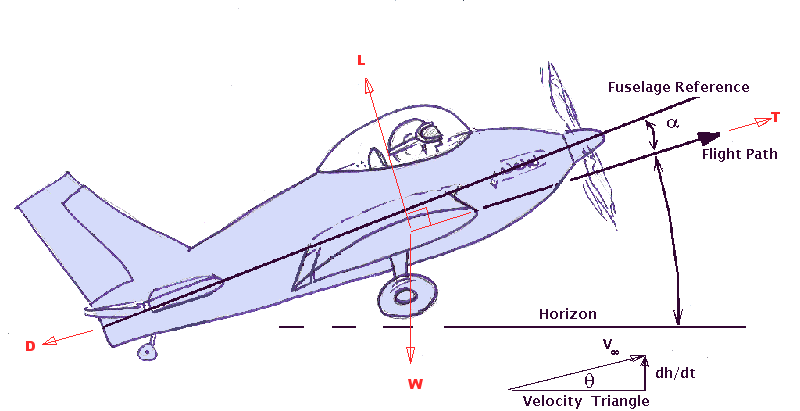|
Climb PerformanceOnce the
aircraft has left the ground and a constant speed climb established, then
climb performance can be simply calculated using a balance of the forces
acting on the climbing vehicle.
In diagram
the vehicle is assumed to be climbing at a constant angle (
The balance
of forces in the direction perpendicular to aircraft flight (z-wind-axis)
will give :
The balance
of forces in the direction parallel to the aircraft flight path (x-wind-axis)
will give :
Normal
aircraft climb at relatively small angles so making the small angle
assumption that
Then by
observing the relationship between climb angle, climb rate and flight
velocity,
The use of
these equations in a numerical scheme is relatively straight forward. At a
given aircraft weight, altitude and flight speed it should be possible to estimate the current
Thrust (T) being produced and the current Drag (D) (see previous section on calculation
of thrust and drag). The
difference between thrust and drag at the specified flight condition can
hence be used to calculate climb angle and climb rate for the aircraft.
Clearly if T=D then the aircraft is not climbing or descending but is in
level flight. Also a obvious consequence is that if T<D then the aircraft
must be descending. These
combination of terms : It is given
the name Specific Excess Power ( Ps ).
The fact
that the terms have velocity * force units involved makes this a term in
power; excess power, because of the assumption that T * V, power
available from engines, is greater
than D * V, power required to overcome energy loss due to motion. The Ps
term is denoted
as Specific since the power terms are divided by the weight of the vehicle so
that it is not being used in absolute terms but relative to the weight of the
vehicle. For this
steady flight analysis Specific Excess Power will create a climb rate but for
dynamic motion of the aircraft it can be used to climb, accelerate or turn.
This will be covered in later chapters. Investigation
of the Specific Excess Power term over a range of flight speeds in the
initial climb at sea level conditions can be used to find important results.
Using the above simple equations in a spreadsheet for example can be used to
predict the flight speed to use that will maximise the climb rate or the
climb angle (Note: These two optima may not occur at the same flight speed).
Sea Level
Climb Performance Spreadsheet. © AMME,
University of Sydney, 1998-2006. |


 ) and
) and  )
)

 , allows the following prediction of climb angle,
, allows the following prediction of climb angle,


 is quite
important in the evaluation of aircraft performance.
is quite
important in the evaluation of aircraft performance.